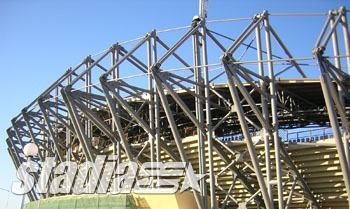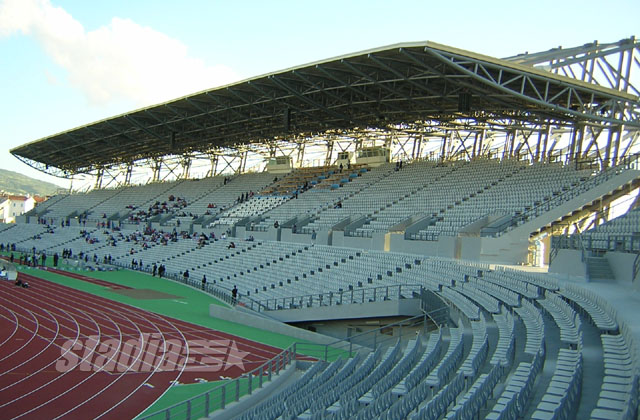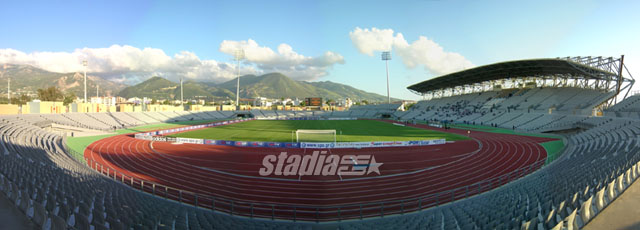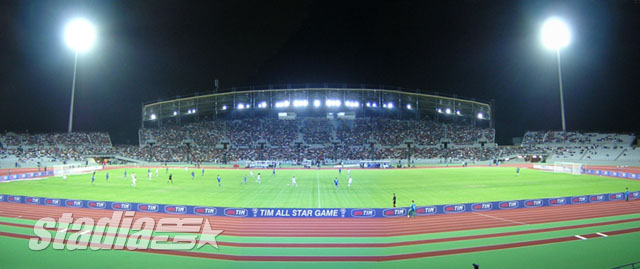| Panpeloponnesian Stadium |
| Capacity: 23,588 (all seated) |
| Location: |
|
The
stadium is located in the southern outscirts of Patras, 220 km west
of Athens. The city has an airport, only used by charter flights.
You can get to Patras by boat from Italy or train from Athens. To
reach the stadium by car from within the
city, find the road leading to Kalavryta. Pass by the "Aghios
Andreas" hospital and at the traffic lights continue straight
ahead towards "Clauss". Go on for another 1.2 km and you'll
come to the stadium. You may also use bus #7 to get
there.
|
|
However,
if you're coming by car from Athens, you
don't need to drive through the city. Follow the motorway bypass towards
Pyrgos and exit at "Patra 3 - Glafkos". After 500m you'll
have to turn right and this will bring you to a roundabout (you will
see a Carrefour supermarket there). Continue north towards the city
of Patras and after about 2 km you'll get to the stadium.
|
| Built
in: 1981 (Latest redevelopment in 2004) |
| Record attendance: 16,839 (Olympiakos CFP vs Larissa, in 1989) |
| Home of: Panahaiki FC (Football League) |
|
More
data: Its Greek name is Pampeloponnissiako Stadio ("Stadium
of the whole Peloponnese"), which refers to the region of which Patras
is the capital. It has been used at various times by local teams.
Panahaiki have used it many times in the past, along with their own
stadium.
Patraikos also used it as home until early 2001, but then returned
to Prosfyghika
Stadium.
|
|
The Panpeloponnesian Stadium was used in the 2004 Olympic Games,
hosting part of the football tournament (six men's games,
including a quarter-final, and five women's matches, of which one
quarter-final and one semifinal). It was for this reason that a large
scale upgrading of the facilities was decided (plans
by architects Grammatopoulos, Panousakis & associates).
Works for the stadium's reconstruction commenced in mid-2002 and finished in early 2004. They were carried out by Empedos SA and Domiki Kritis SA at a cost of about € 30 million. |
|
In
particular, these works included: the construction of a new west stand,
which is covered by a roof; the installation of plastic seats and
electronic scoreboards; the replacement of all electro-mechanical
installations, including new lighting and closed cirquit TV; the refurbishment
of all stadium facilities below the stands etc. On the right, you
can see the general topographical plan of the Panpeloponnesian National
Sports Centre. You may view it in full size by clicking on it -->
|
|
Finally,
note that the latest reconstruction allows for a further expansion
of the stadium. A new east stand can easily be built in the future,
identical to the west one that was constructed for the Olympics. If
and when this happens, it will add about 6,500 more seats to the overall
capacity and turn the Panpeloponnesian into a superb sports venue.
This will be in stark contrast with the almost deserted stadium that
stood in its place until 2002 (it had a capacity of about 18,000 without
seats). You may see photos that show what the stadium looked like
before the recent works: 1,
2, 3,
4, 5.
The revamped Panpeloponnesian Stadium was opened to the public on 28 March 2004, when it hosted the final of the Patras local amateur league. All photographs on this page were shot on 10 May, during the 2004 TIM All-Star Game. You may see both the first and last of these photos in full size, if you click on them. It is owned by the Public Properties Company and operated by the Municipality of Patras |
 |
 |



